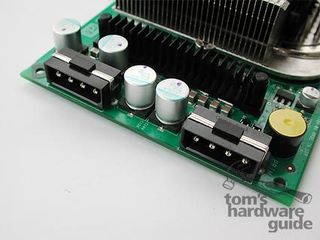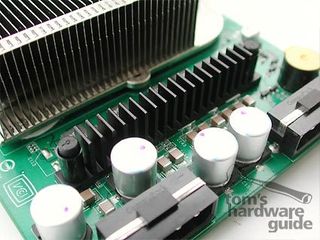Performance Leap: NVIDIA GeForce 6800 Ultra
The Hardware, Continued
While we're on the topic of massive - the power requirements of the GF 6800 Ultra are just that as well. The card sports two auxiliary power connectors. NVIDIA prescribes that each of them receive a four-pin molex connector from an ATX power cable that is not connected to other devices, with the exception of fans. In English - each of the ports requires a dedicated ATX power cable, and both need to be connected! This may pose a problem for many users, since even many of the more powerful power supplies often only feature a total of three ATX power cables. That would leave one cable for all of the remaining devices in the system, e.g. hard drives, optical drives and the like.
To satisfy the 222 million transistor behemoth's hunger for power, NVIDIA strongly suggests the use of a power supply with a minimum capacity of 480 Watts. According to NVIDIA's numbers, the 6800 Ultra draws about 110 Watts, 2/3 of which are used by the GPU. That makes its power draw about 25% higher than that of the GeForce FX 5950 Ultra. It would seem, then, that the power requirements aren't really that high. Instead, the suggestion for such a large power supply stem from the fact that in practice, systems using the 6800 Ultra will need a PSU with four power cables. Obviously, the PSU itself has to be strong enough to satisfy this requirement.

Each of the two molex connectors requires a dedicated ATX cable. The alignment of the connectors may cause trouble when installing the long card in some ATX cases.

The voltage converters have their own heatsink.
In addition to the GeForce 6800 Ultra, NVIDIA will also offer a GeForce 6800, which will be identical to the Ultra in feature set but will only have 12 pixel pipelines, one molex connector and a single-slot cooler.
Prices:
- 6800 Ultra, $499, 16 pipes, two Molex connectors, two slots, 400/550
- 6800, $299, 12 pipes, one Molex connector, one slot, TBD
Stay on the Cutting Edge
Join the experts who read Tom's Hardware for the inside track on enthusiast PC tech news — and have for over 25 years. We'll send breaking news and in-depth reviews of CPUs, GPUs, AI, maker hardware and more straight to your inbox.
Most Popular

